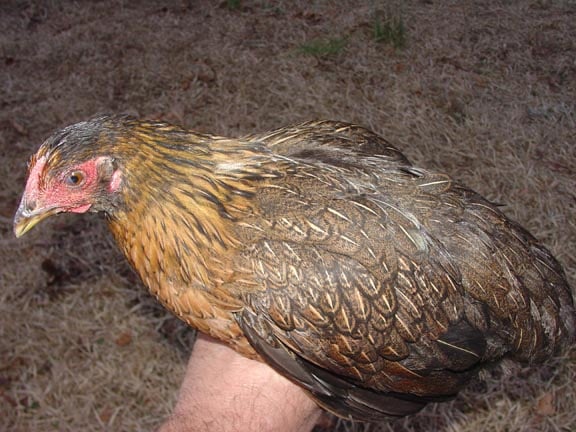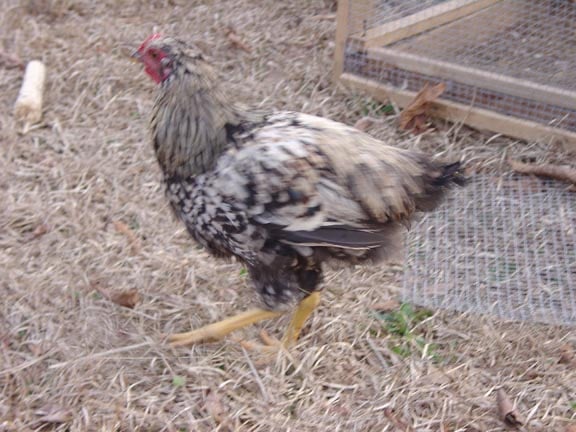I've been working on these birds since early 2014 so 9 years total. I started with Silver Laced Wyandottes from [Jerry foley](http://www.foleyswaterfowl.com/) and blue egg laying brown leghorns with straight comb from Keith Bramwell at UARK. There were some really big genetic reasons for using these two lines and some gotchas which came with the genetics. Jerry Foley's birds carry two comb genes, one for a walnut like comb without a tip and the other for rose comb. Combined, the two genes produce a flat rose comb. This is very advantageous in a cold climate. The blue egg laying Brown Leghorns were specifically chosen because they have a straight comb, bright blue large to very large eggs, and a laying cycle of about 270 to 300 days per year. Wyandottes rarely lay more than 220 eggs per year and they are medium brown - coated with porphyrin. The major negative gene from the Leghorns is partridge phenotype. This shows up as feathers that are double laced along with "salt and pepper" speckles of dark on light background. This is relatively difficult to breed out. One other significant gene from the Leghorns is zinc white eggshells. The shells are very thick with fully saturated white undertones. Zinc white suppresses porphyrin to a high degree such that eggs develop a sandy tan color if the porphyrin biopath is turned on.
I will post some pictures from early in the breeding and others from later up to today 1/10/2023. I have not kept up with the number of generations, each bird has been selected based on SLW phenotype along with large blue eggs. I obtained eggs and chicks in early 2014 that laid first eggs that fall. I made crosses and by 2015 was picking which F1 birds to breed to further the objective of a phenotypically SLW bird (black laced, rose comb) that lays blue eggs.
I will start with a few pictures taken a few minutes ago as the chickens were going on the roost. If you have taken chicken pics, you have an idea how hard it is to get them to stand still. In this pic, there are 6 young (4 to 5 month old) chicks. Three young hens show the salt & pepper effect from the Brown Leghorns. Crossed with a laced rooster, half the eggs they lay will produce well laced chicks and the other half will have the salt & pepper feathers. There is one cockerel top center that is much better in terms of lacing but still has some of the salt & pepper mottling. Left center is a cockerel with too much white, he will be culled. I have several young hens with similar coloring. Crossed with a laced rooster, they usually produce some decent chicks.

In this picture, some young birds of similar age show a few more flaws. The hen on the left has some mahogany in her wings, 2nd from the right is a cockerel with too much white, and the other two are young hens with moderate lacing. Again, crosses to a nice laced rooster will clean up most of the flaws.

In this last picture, a young hen that should start laying in February shows good lacing though she is straight comb. She is going in a breeding pen with my best laced rooster that is homozygous for blue eggs.

I will post some pictures from early in the breeding and others from later up to today 1/10/2023. I have not kept up with the number of generations, each bird has been selected based on SLW phenotype along with large blue eggs. I obtained eggs and chicks in early 2014 that laid first eggs that fall. I made crosses and by 2015 was picking which F1 birds to breed to further the objective of a phenotypically SLW bird (black laced, rose comb) that lays blue eggs.
I will start with a few pictures taken a few minutes ago as the chickens were going on the roost. If you have taken chicken pics, you have an idea how hard it is to get them to stand still. In this pic, there are 6 young (4 to 5 month old) chicks. Three young hens show the salt & pepper effect from the Brown Leghorns. Crossed with a laced rooster, half the eggs they lay will produce well laced chicks and the other half will have the salt & pepper feathers. There is one cockerel top center that is much better in terms of lacing but still has some of the salt & pepper mottling. Left center is a cockerel with too much white, he will be culled. I have several young hens with similar coloring. Crossed with a laced rooster, they usually produce some decent chicks.
In this picture, some young birds of similar age show a few more flaws. The hen on the left has some mahogany in her wings, 2nd from the right is a cockerel with too much white, and the other two are young hens with moderate lacing. Again, crosses to a nice laced rooster will clean up most of the flaws.
In this last picture, a young hen that should start laying in February shows good lacing though she is straight comb. She is going in a breeding pen with my best laced rooster that is homozygous for blue eggs.




